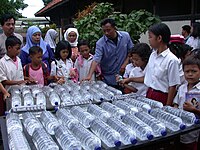
Photo from wikipedia
Abstract We studied the benefits of peanut (Arachis hypogaea L.) intercropping (I) or relaycropping (R) with cowpea (Vigna unquiculata L.) and fertilizer application rates (unfertilized control, N; chemical fertilizer, C;… Click to show full abstract
Abstract We studied the benefits of peanut (Arachis hypogaea L.) intercropping (I) or relaycropping (R) with cowpea (Vigna unquiculata L.) and fertilizer application rates (unfertilized control, N; chemical fertilizer, C; organic manure, O; 50% C + 50% O, H) on soil biological properties of an Udic Mollisol. The crop multiple cropping and peanut monocropping (M) were established in 2002 and fertilizer was applied to any plots. We hypothesize that peanut/cowpea multiple cropping harbour a greater microfauna diversity, while organic mature application support a more complex soil food web and soil functioning. Combined the two factors implies a beneficial soil ecosystem for peanut production via repelling PPNs. The results showed microbial C and N over the growing season were 39.2% and 30.7% greater when peanut was intercropped and relaycropped than in monocropping plots. Total organic C, total N and alkali hydrolysable N were average 24.6%–43.1% greater when organic manure was applied than in the chemical fertilizer plots. Soil nematode community in peanut monocropping was dominated by plant parasites, mainly from Meloidogyne spp., but their abundance decreased when cowpea was associated to peanut. The cowpea also impacted other trophic groups. The proportion of bacterivores and high colonizer-persister (c-p) value omnivore-carnivores was increased in multi-cropping plots. The abundance of protozoa and fungivores were 36.9% and 29.8% greater in mixed manure plots than in no fertilization plots at flowering stage. The increased diversity indices (H′) and ecological indices (EI and SI) of the nematode communities indicated less disturbance and high soil fertility in multiple cropping systems. Overall, peanut multi-cropping with manure had a positive effect on peanut rhizosphere soil conditions.
Journal Title: Geoderma
Year Published: 2019
Link to full text (if available)
Share on Social Media: Sign Up to like & get
recommendations!